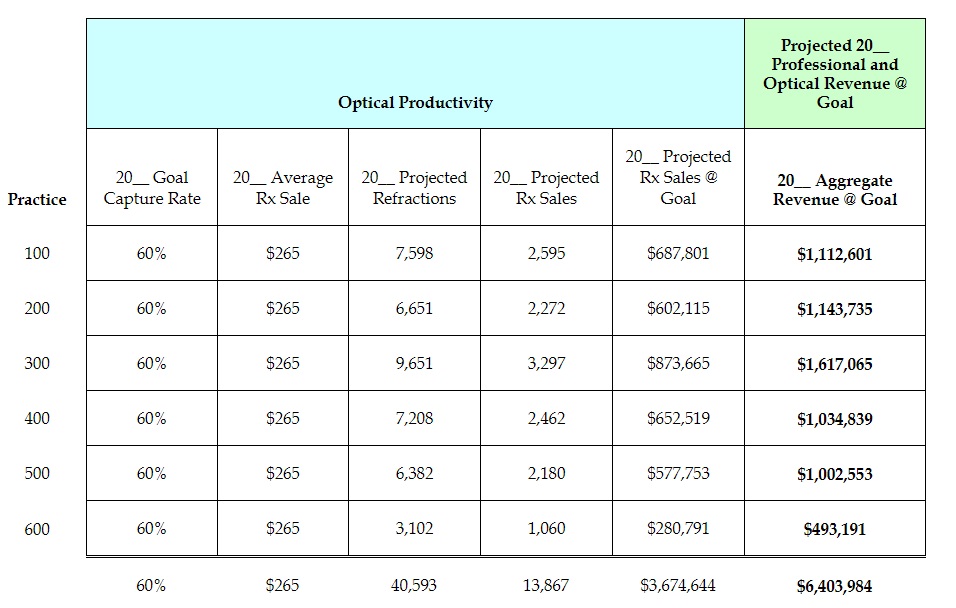By Steve Sunder

May 15, 2019
As a practice owner, you have a lot to track financially. One way to stay on top of financial needs, and your ability to make further investments, is by creating and implementing a capacity plan.
The business definition of a capacity plan is “the process of determining the production capacity needed by an organization to meet changing demands for its products, according to Wikipedia. In the context of capacity planning, design capacity is the maximum amount of work that an organization is capable of completing in a given period.”
Other Articles to Explore
In an OD practice, the capacity plan is a methodology that calculates the potential number of patients the optometrist(s) can physically see and the number of eyeglass sales based on the patient visits. If a practice capacity isn’t created, then the optometrist(s) really doesn’t know what their practice can feasibly generate.
The primary purpose of the capacity plan is to understand what the actual output (professional and optical revenues) of the practice is based on the number of optometrist(s) and optical sales from the examinations performed. Without a capacity plan, a practice can’t create a realistic budget. The capacity plan should be created and used as the foundation of the budget. Once created and implemented, it can be used to justify additional spending on practice improvements.
Based on my more than 40-year experience as an executive at multi-location primary eyecare practices, the capacity plan is a useful financial tool for all sizes of practices, from the single OD to multiple ODs and locations.
During my time as a senior executive at one of the practices where I worked, my executive team and I used a capacity plan to aid staffing calculations, marketing plans and financial allocations and major equipment acquisitions.
What Do I Need to Know to Create a Capacity Plan?
To create the capacity plan, we need to know the amount of time the optometrist(s) is out of the office for CME, vacation and holidays, then we need to set practice objectives:
A. The OD time out of the office is non-revenue generating, so we must take this time into account.
B. Practice objectives are the drivers of the capacity plan such as:
i. Optometrist(s) patients per hour
ii. Optometrist(s) revenue per hour
iii. Optometrist(s) weekly patient clinic hours
iv. Percent of complete revenue generating exams/visits…in my experience 65 percent minimum
v. Optical capture rate
vi. Optical average Rx sale
C. With these data points I can calculate the following:
i. Annual weeks the OD(s) are available for patient care
ii. Annual OD(s) calculated projected complete eye exams
iii. Annual projected revenues
iv. Annual Optical Rx capture
v. Annual Optical revenue
vi. Aggregate practice revenues
Once Created, How Do I Use It?
The capacity plan drives the patient schedule and the practice budget. Knowing the annual practice visit capacity, the patient schedule can be created with at least 65 percent complete eye exams. This may require opening up more patient exam slots. More revenue generating slots, more practice revenue.
Here are examples of how capacity would look charted out:


Do Capacity Plan Yearly & Adjust as Needed
The capacity plan should be done yearly, especially if there have been OD staffing level changes or location changes, and used in supporting the creation of the next year’s budget. The capacity plan should be adjusted as well as the budget if there are mid-year staffing changes.
Be Meticulous in Using Accurate Numbers
Not applying the correct OD time out of the office will render your capacity plan useless. If this miscalculation is discovered, a new capacity plan with the correct OD time off must be created.
 Steve Sunder is a health-care consultant with over 40 years experience in the eyecare industry, including over 20 years at a multi-location practice, and years of work as a consultant to other practices. To contact him: steve@sundervisionsolutions.com
Steve Sunder is a health-care consultant with over 40 years experience in the eyecare industry, including over 20 years at a multi-location practice, and years of work as a consultant to other practices. To contact him: steve@sundervisionsolutions.com





















